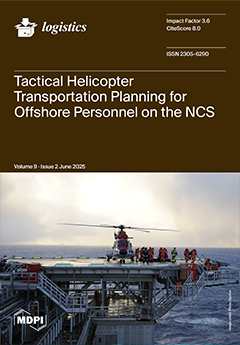Background: Economic logistics in fire and rescue services is a critical determinant of operational readiness, fiscal sustainability, and resilience to large-scale emergencies. Despite its strategic importance, logistics remains under-researched in Central and Eastern European contexts, where legacy governance structures and EU-funded modernization
[...] Read more.
Background: Economic logistics in fire and rescue services is a critical determinant of operational readiness, fiscal sustainability, and resilience to large-scale emergencies. Despite its strategic importance, logistics remains under-researched in Central and Eastern European contexts, where legacy governance structures and EU-funded modernization coexist with systemic inefficiencies. This study focuses on the Slovak Fire and Rescue Service (HaZZ) as a case to explore how economic logistics systems can be restructured for greater performance and value.
Objective: The objective of this paper was to evaluate the structure, performance, and reform potential of the logistics system supporting HaZZ, with a focus on procurement efficiency, lifecycle costing, digital integration, and alignment with EU civil protection standards.
Methods: A mixed-methods design was applied, comprising the following: (1) Institutional analysis of governance, budgeting, and legal mandates based on semi-structured expert interviews with HaZZ and the Ministry of Interior officers (
n = 12); (2) comparative benchmarking with Germany, Austria, the Czech Republic, and the Netherlands; (3) financial analysis of national logistics expenditures (2019–2023) using Total Cost of Ownership (TCO) principles, completed with the visualization of cost trends and procurement price variance through original heat maps and time-series graphs.
Results: The key findings are as follows: (1) HaZZ operates a formally centralized but practically fragmented logistics model across 51 district units, lacking national coordination mechanisms and digital infrastructure; (2) Maintenance costs have risen by 42% between 2019 and 2023 despite increasing capital investment due to insufficient lifecycle planning and asset heterogeneity; (3) Price variance for identical equipment categories across regions exceeds 30%, highlighting the inefficiencies in decentralized procurement; (4) Slovakia lacks a national Logistics Information System (LIS), unlike peer countries which have deployed integrated digital platforms (e.g., CELIS in the Czech Republic); (5) Benchmarking reveals high-impact practices in centralized procurement, lifecycle-based contracting, regional logistics hubs, and performance accountability—particularly in Austria and the Netherlands.
Impacts: Four high-impact, feasible reforms were proposed: (1) Establishment of a centralized procurement framework; (2) national LIS deployment to unify inventory and asset tracking; (3) adoption of lifecycle-based and performance-based contracting models; (4) development of regional logistics hubs using underutilized infrastructure. This study is among the first to provide an integrated economic and institutional analysis of the Fire and Rescue Service logistics in a post-socialist EU member state. It offers a structured, transferable reform roadmap grounded in comparative evidence and adapted to Slovakia’s hybrid governance model. The research bridges gaps between modernization policy, procurement law, and digital public administration in the context of emergency services.
Full article





